A manager walks into her first all-hands after a reorg.
She’s new to the team, but not to the company. She’s familiar with the names, less so with the decisions made under those names. The deck loads. There’s a progress slide. A compliance update. A graph on delivery timelines. The tone is clear. The rhythm is routine. But nothing in it answers the question running through the room: how did we get through the last six weeks?
There’s no mention of the night shift that fixed the logistics breakdown before anyone else noticed. No reflection on the team that covered two missing roles while onboarding a new hire. No sign that the effort was seen, let alone remembered.
The meeting continues. Alignment is stated. Metrics are acknowledged. But something is missing. Not information. Not intention. Something harder to measure. What it meant to hold the line. What it felt like to keep going while still unsure of the outcome. That part isn’t in the slides. It rarely is.
This is where the “Inspire Me” dimension of the Internal Comms User Needs Model becomes not just helpful, but essential. It repositions inspiration not as garnish for the culture, but as part of the core structure. Something that doesn’t just appear in high points or corporate videos, but something employees encounter often, in small, quiet, recognisable ways that create memory and belonging.

How to implement “Inspire Me” messaging
Most communication strategies focus on message transmission. Alignment. Clarity. Timeliness. Those are useful mechanics. But when it comes to meaning, the kind that anchors memory and builds belief, mechanics fall short. You’re no longer just trying to inform or guide. You’re trying to make people feel the weight of what they’ve done, what they’ve been part of and what that effort adds up to.
This isn’t about writing more heartfelt messages or packaging success in emotional language. That’s often how inspiration is misunderstood: a tone shift, a quote here and there, a feel-good segment tacked onto a town hall. But if the purpose is to make values observable and shared reality coherent, then inspiration must be built into the system itself.
It’s not the message that inspires. It’s how the message fits into a pattern that makes people feel like they’re not being talked at, but recognised inside a story they helped shape.
That requires structure.
The following five components aren’t tactical one-offs. They are design levers. Elements you operationalise across time, context, and channel. Not to create emotion as an effect, but to make space for it to show up when and where it matters.
1. Storytelling as connective tissue
Storytelling inside organisations often arrives late. Once the work is done. Once the numbers are in. Once the narrative can be shaped to reflect well on the outcome. That’s when the internal newsletter picks it up, or a slide deck slot opens at the all-hands. These stories tend to sound clean, sometimes even impressive, but they’re difficult to recognise. And if employees can’t recognise themselves in the version that’s being told, it does little for connection.
The most memorable parts of work rarely happen at the finish line. They live in the difficult middle. The stretch where nobody knew how things would turn out. Where someone had to make a call without full information. Where someone else picked up a thread that wasn’t theirs to carry, but did it anyway.
This is the space most internal comms overlook. Not because it lacks substance, but because it lacks certainty. It doesn’t fit neatly into formats built around achievements. And yet, this is where meaning forms.
If your communication system only highlights the finished work, you end up building a public record that remembers performance, but forgets what it took to get there.
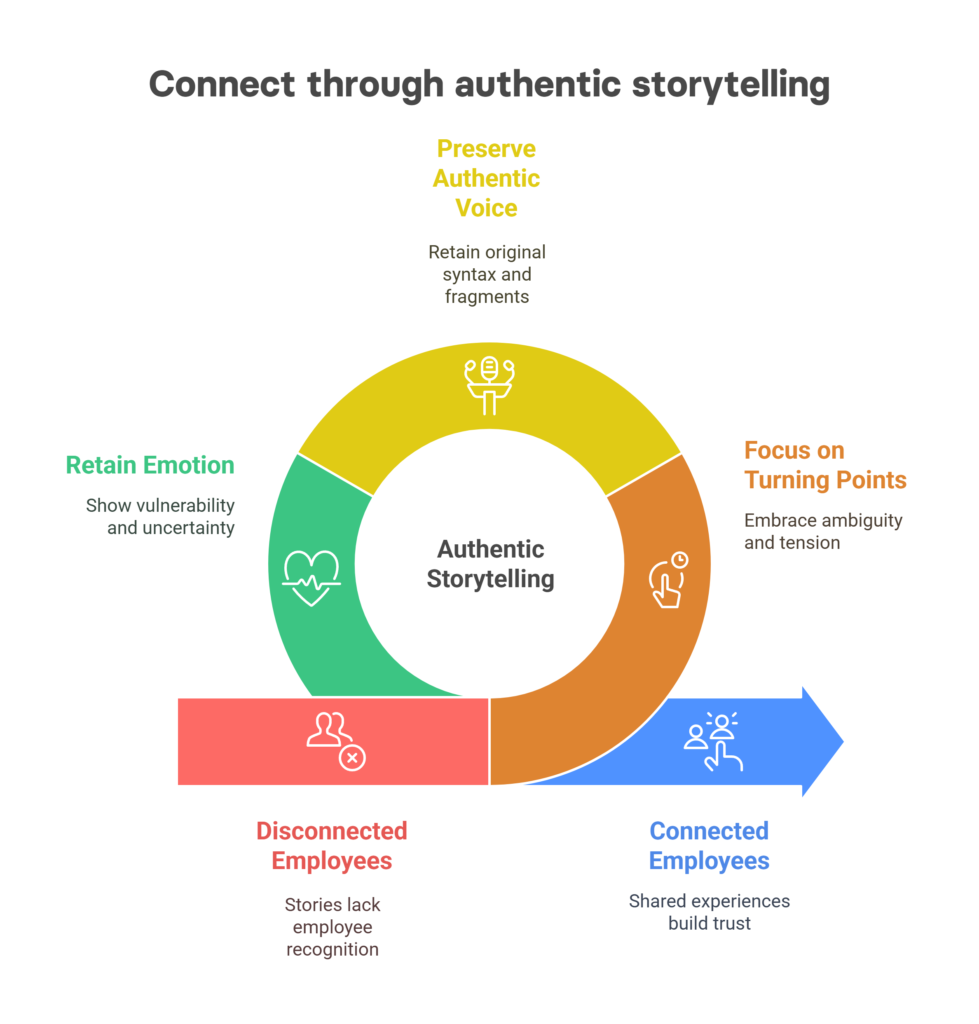
To shift that:
- Design your story formats around turning points, not just results. Make room for ambiguity. Allow tension to stay visible in the telling. What was unclear? What made this difficult? What helped things move?
- Let the voice remain close to source. Don’t clean up the syntax. Don’t over-edit for polish. The most honest stories rarely arrive in grammatically perfect prose. They arrive in fragments. That’s part of what makes them real.
- Stop removing the emotion. This doesn’t mean adding flair or drama. It means leaving in the pause where someone says, “I wasn’t sure what to do.” Or the moment when a team member admits they thought it might fall apart. These are not liabilities. They are the human architecture of trust.
What you’re trying to surface isn’t inspiration as a message. It’s experience as pattern. The kind people can recognise even if they weren’t there, and carry with them as reference.
2. Spotlight individuals as meaning-makers
Most internal recognition follows a familiar script. Someone completes something noteworthy. A leader or HR manager names them publicly. A quote is sourced, often secondhand. A photo is shared. Sometimes it lands. More often, it passes unnoticed.
The issue isn’t the act of recognition itself. It’s the packaging. When everything is framed as exemplary, the distinctions blur. And when language is always neat like “demonstrated excellence,” “went above and beyond,” “lived our values”, the substance disappears.
What people want is not to be celebrated as symbols, but to be seen in context. To have the moment understood in its texture. What made it hard. What made it matter. What wasn’t obvious to others, but still got done.
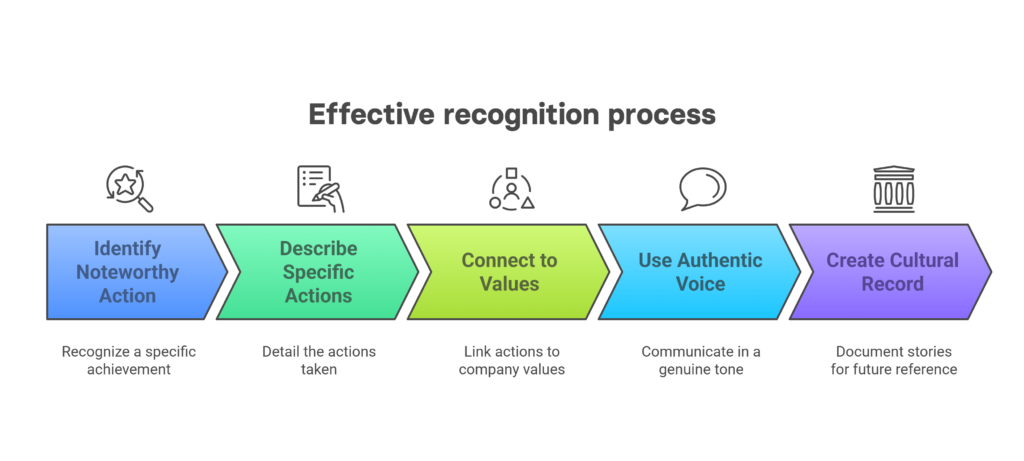
If you’re trying to embed inspiration through recognition, the goal isn’t scale. It’s fidelity.
- Start from the action, not the headline. What did the person actually do? Not in general terms, but in the small decisions that carried weight. That moment in a call where they held a boundary without losing trust. The workaround they built that no one asked for, but everyone needed.
- Tie it to values but make the value legible. Don’t say “integrity.” Say: “She pushed back when the numbers didn’t feel right, even though it meant delaying the release.”
- Keep the voice close. That might be a Slack thread between peers. A short audio note. A screenshot with context. Avoid rewriting into formal tone. The further you get from the real moment, the more the recognition becomes theatre.
- Don’t treat it as a feed that scrolls away. Create space where people can revisit these stories. Search by theme, by value, by domain. Recognition is part of the cultural record, not just this week’s applause.
Done well, this isn’t just a morale play. It’s how culture becomes teachable. Not through policy or training, but through lived patterns that others can follow. You’re not codifying heroes. You’re creating reference points.
3. Invite leadership to narrate, not just announce
Much of what’s published under a leader’s name feels precise. Well-written, structured, correct. But the closer you look, the more it reads like it was processed through layers of review until nothing difficult remained.
There’s an underlying assumption in many organisations that leadership communication exists to reinforce confidence. That it must be polished to preserve authority. The result is messaging that gets facts across, but flattens the experience of leading into talking points. It leaves no trace of the human who wrote it or the struggle behind the decision.
What often goes missing is the interior of leadership. The part that carries tension, doubt, unfinished thought. Not to manufacture vulnerability, but to share the thinking that doesn’t always fit in bullet points.
This is not about replacing structure with storytelling. It’s about making space for narrative presence. The kind that doesn’t try to conclude everything. That allows a pause. A shift in tone. A sense that the leader is still working through it, too.
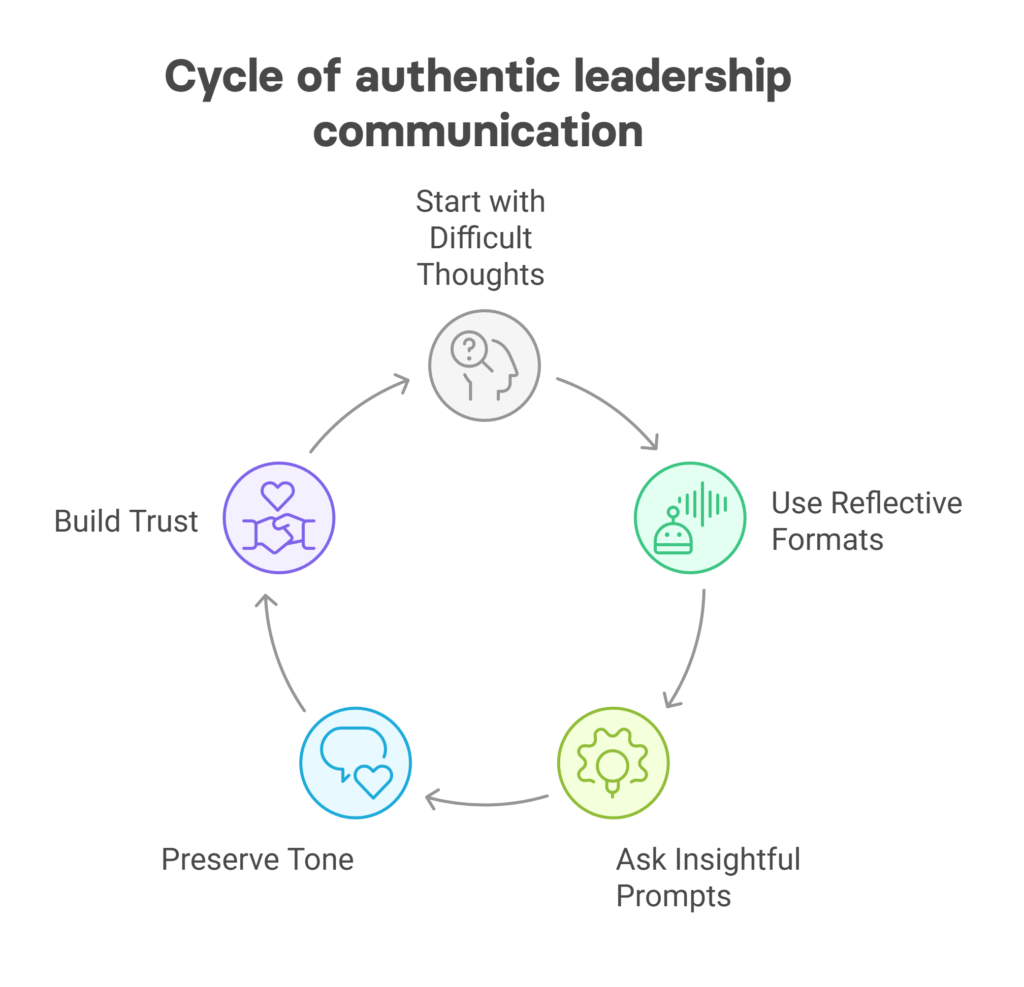
To do that, you need to change the input and the format:
- Don’t start with what needs to be said. Start with what was hard to say. That’s where the useful material often lives. The moment they weren’t sure. The tradeoff they hesitated on. The signal they almost misread.
- Switch from formats built for broadcasting to formats built for reflection. That might be a 60-second voice note, recorded on a walk between meetings. A short internal podcast episode with a peer. An informal response to three unscripted questions shared with the team.
- Ask better prompts. What surprised you this week? What did the team see that you missed? What felt harder than expected? These aren’t performance metrics. They’re process insights. And when shared, they give employees a more realistic mental model of what leadership actually looks like in practice.
- Preserve tone. Resist the instinct to polish every message into alignment. People know the difference between presence and performance. A message that arrives slightly imperfect but fully real will always carry more weight than one that was technically right but emotionally empty.
When leaders make their thinking visible, it doesn’t dilute authority. It builds trust in how that authority is exercised. People learn what’s guiding decisions. They begin to understand not just what the direction is, but why it feels the way it does.
4. Build rhythm, not bursts
One of the most common mistakes in internal communication is treating inspiration like a spotlight. It gets turned on during big moments (launches, all-hands, milestones) and then goes dark. The message might land, but the signal doesn’t last. It doesn’t imprint.
People don’t build meaning from isolated peaks. They build it from the patterns they come to expect. From what shows up every week. From what becomes part of the texture of how work is shared, observed and remembered.
Inspiration, in practice, is rarely loud. It moves in small, patterned signals. A brief reflection dropped at the end of the week. A recurring moment of recognition on Tuesdays. A monthly reminder of what it feels like to belong here, not because the calendar says it’s time for culture, but because culture is being documented as it unfolds.
What holds meaning is not the form. It’s the cadence. Predictability doesn’t dilute impact. It builds anticipation. People begin to notice, not just what’s being said, but when and how it arrives. Over time, the medium becomes a message of its own.
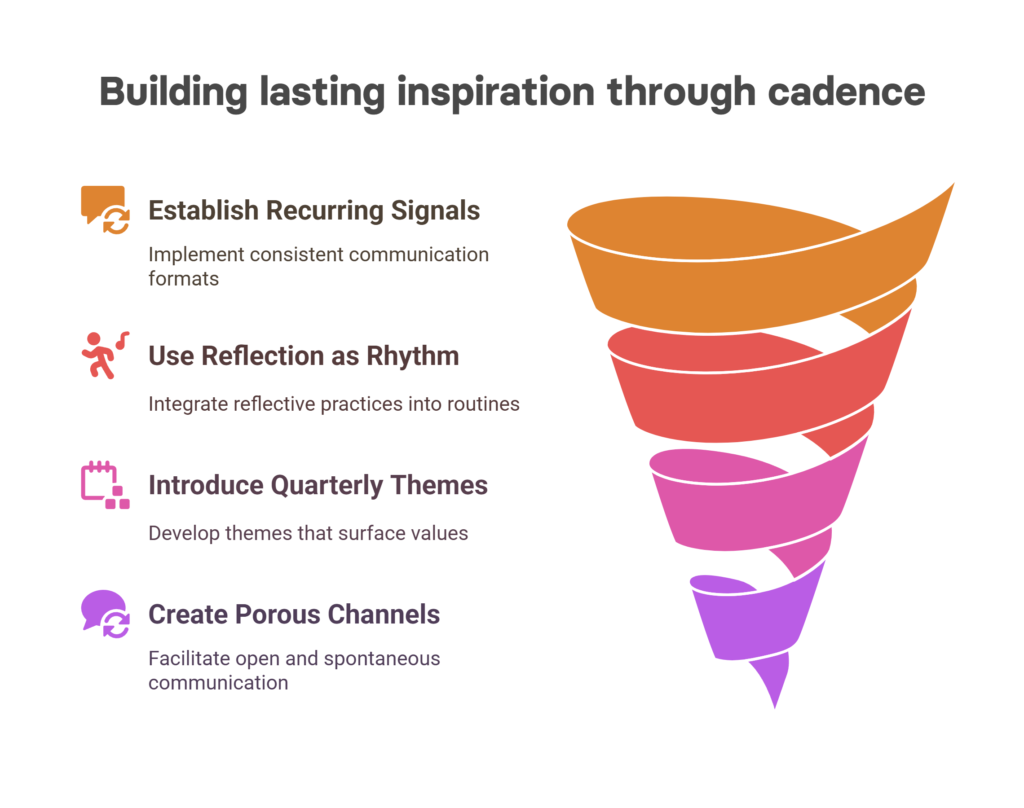
To make this structural:
- Establish low-friction, recurring signals. Not campaigns. Not formal programs. Just formats that persist. A weekly “work-in-motion” post where teams share a moment they’re proud of. A recurring Slack thread asking what felt hard and what felt meaningful.
- Use reflection as rhythm, not resolution. Monthly notes from leaders don’t have to recap performance. They can surface learning. One thing they got wrong. One thing that surprised them. One thing they’re still thinking about.
- Introduce quarterly themes that don’t just explain values, they surface them. For example, don’t announce “this is our quarter of trust.” Instead, ask teams to show you what trust looked like. Collect the stories. Share the patterns back.
- Create porous channels. Not every act of recognition should require approval. Make space where micro-stories, appreciations and observations can move on their own. Then surface the ones that resonate most.
Rhythm doesn’t mean routine. It means repeatability without sameness. Done right, it creates conditions where inspiration no longer needs to be manufactured. It just needs to be noticed.
5. Use multimedia to preserve tone
There’s a limit to what text can carry. It gets the point across, but too often leaves the emotional temperature behind. Tone flattens. Context blurs. A thank-you lands as polite rather than personal. An update that felt hard to write reads as just another line of comms.
You can’t fix that with more adjectives. You fix it by using formats that can hold nuance. Not for visual variety. For fidelity.
A leader’s voice memo after a tough week doesn’t need music, transitions or framing. What makes it land is the breath they take before saying something they weren’t sure how to phrase. The slight shift in tone when they speak about a colleague who carried more than their share. That’s the signal that sticks.
Multimedia creates space for that kind of closeness, especially when it doesn’t feel staged. The best clips are often casual. Recorded on the walk from one meeting to the next. Sent before someone has time to script what they’re trying to say.
These moments work not because they’re polished, but because they’re intact. The tone hasn’t been diluted. The human presence is still there.
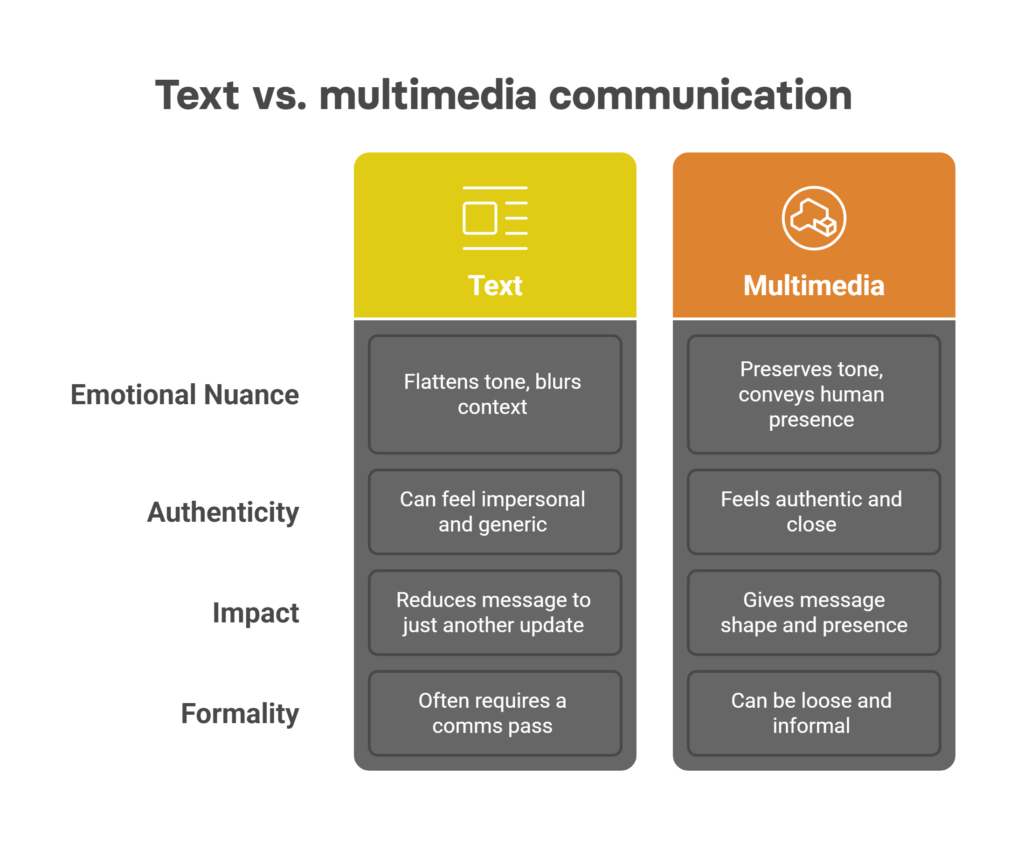
To build this into your system:
- Ask teams to send short clips when something lands well. No editing. No slide decks. Just a 45-second message about what worked and why it mattered.
- Let leaders default to voice when the message is hard to reduce to bullet points. Give them permission to be loose. Not every message needs a comms pass.
- Treat ambient sound and informal background as part of the content. A shop floor humming. Laughter from the other side of the call. These fragments help locate the moment in something real.
What you’re preserving isn’t just tone. It’s proximity. When people hear someone speak from the middle of their workday rather than from a branded studio, it doesn’t just feel authentic. It feels close.
And in distributed teams, with fractured attention and constant context switching, that kind of closeness is what keeps the message from being just another update. It gives it shape. It gives it presence.

How to know it’s working
You won’t see the effects of inspiration in open rates. It doesn’t flash. It accumulates. Quietly. Often in ways that are only visible if you’re paying attention to the right signals over time.
Not every change shows up in numbers. But when people start remembering stories they weren’t in, when they quote each other in meetings, when they pass something along because it felt like it meant something. That’s movement.
Some of it will be measurable. Some of it won’t. But the clues are there.

Tier 1: Activity
Look at what people do when no one’s asking them to perform.
- Peer recognition that happens outside of the formal channels
- People using the “shoutout” threads without being prompted
- Teams sending clips, photos or messages that weren’t scheduled or required
It’s not the volume alone. It’s whether the signal is spreading on its own.
Tier 2: Language
This is the part most dashboards miss.
- Phrases from a recent story showing up in a team lead’s check-in
- A leader quoting a frontline employee in a town hall, not as a token, but as an anchor
- Colleagues describing moments as “that felt like us,” without being fed a script
When the language of the organisation starts forming from the inside, you’ll know something is taking hold.
Tier 3: Emotion
The numbers will trail the behaviour, but they catch up eventually.
- A shift in pulse survey scores, not just in satisfaction, but in things like “belonging,” “recognition” or “feeling trusted”
- Fewer exit interviews citing feeling invisible or underappreciated
- More volunteers for internal initiatives, side projects or working groups that reflect shared priorities rather than individual ambition
This isn’t about performance metrics. It’s about emotional signal. Whether people feel seen. Whether they want to contribute beyond the task list. Whether the culture is something they can locate themselves in, not just observe from a distance.
Why “Inspire me” works (the evidence)
👉 Gallup found that consistent and meaningful recognition increases engagement by up to 20x.👉 The O.C. Tanner Institute reported that celebrating employee achievement drove a 21% boost in engagement and 17% rise in productivity.
👉 Deloitte’s research shows emotionally resonant comms improve collaboration by 29% and decision-making quality by 20%.
Crisis communications is the hardest place to sustain belief
Crisis forces clarity. Not always in what’s said, but in what’s felt.
In calm periods, inspiration is easy to treat as a luxury. Something reserved for offsites, campaigns and wrap-up speeches. But when the ground shifts, when people are unsure what’s next or whether what they’re doing still matters, that’s when the absence of belief becomes obvious.
In those moments, information travels fast, but trust travels slow.
Take the internal memos from Howard Schultz during Starbucks’ 2008 downturn. They weren’t branded messages or morale plays. They were specific. Candid. Often uncomfortable. He spoke about what was at risk, who would be affected and how he was making sense of it. He didn’t hide his uncertainty behind corporate phrasing. He gave it shape, without reducing it to slogans.
That doesn’t mean every leader needs to write like Schultz. But it does point to something foundational: people don’t want spin. They want something to hold onto.
What helps in these moments has very little to do with updates. It has to do with whether the communication acknowledges what people already know but haven’t heard reflected yet. Whether it recognises the strain. Whether it names the effort being made behind the scenes, not just the plan moving forward.
Design cues to work with:
- Don’t start with tasks. Start with tone. Even a sentence or two that says “We know this is hard” builds more steadiness than a polished roadmap that skips over it.
- Surface signals that haven’t been scripted. A team covering a shift for someone else. A manager who paused a deliverable to check in. These things won’t make headlines. But they anchor identity.
- Don’t rush the reset. It’s tempting to move into “next steps” quickly. But trust doesn’t accelerate on command. Let people sit with what just happened, and show that leadership is sitting with it too.

What Zappos designed differently
Zappos didn’t manufacture culture through internal branding or keynote slides. It didn’t rely on sentiment to fill the gaps. It built processes that made recognition habitual, informal and hard to ignore.
The signals weren’t loud. But they were persistent.
Peer bonuses weren’t just financial tokens. They became tools for lateral acknowledgement, quiet mechanisms that gave employees the means to surface appreciation without needing managerial permission. When someone did something that mattered, you didn’t log it for HR to filter later. You named it. Right there. In the moment. As part of the working rhythm, not apart from it.
Storytelling, too, wasn’t reserved for exceptional circumstances. Stories were part of how new people were introduced to the company. Part of how values were made visible in everyday settings. Not as slogans, but as scenes. Not delivered top-down, but shared across floors and shifts and systems.
Leadership presence didn’t arrive through town halls. It came through tone. Leaders were visible not because they repeated the mission, but because they showed up where the work was, with language that reflected they’d seen it first-hand.
There’s no grand narrative here. Just a system with the friction removed. A way of working where recognition didn’t feel like performance. Where culture wasn’t protected by policies, but reinforced by behaviour. And where inspiration had a place to land because the infrastructure didn’t require it to be perfect or pre-approved.
Design for belief
Belief doesn’t arrive on demand. It builds in layers, often quietly, through moments that don’t announce themselves as important. It forms when people recognise something in the way things are done, something that makes them feel seen, not just surveyed.
You can’t install that with a campaign. You construct it through how communication is allowed to behave inside the organisation.
You give it rhythm. You give it tone. You build formats that don’t flatten everything into neutral statements. You create space where emotion doesn’t need to be squeezed out for the sake of clarity.
When internal comms starts to carry weight beyond its words, when it stops being an exercise in alignment and starts behaving like a memory system, something shifts. People stop scanning for what’s relevant. They start listening for what feels real.
“Inspire Me” isn’t about provocation. It’s about presence. It’s not about framing a message to lift morale. It’s about ensuring the way things are communicated reflects the conditions people are working in, the effort they’re putting forward and the values they’re anchoring to, without needing to say them out loud.
If belief is to hold through ambiguity and change, it needs to be designed into the system. Not once. Not occasionally. But structurally. So that even when things get hard, the signal doesn’t disappear.
That’s not a feature of good internal communication. It’s the function that makes the rest of it matter.








